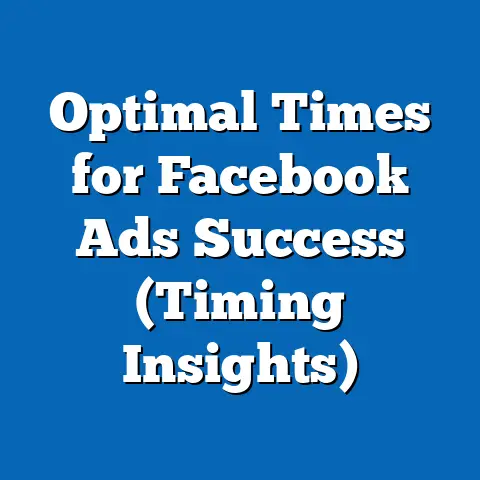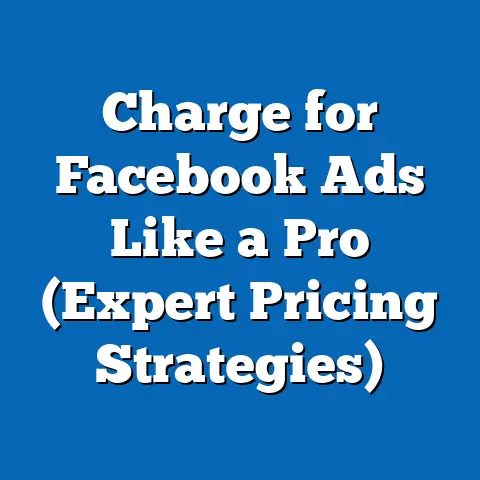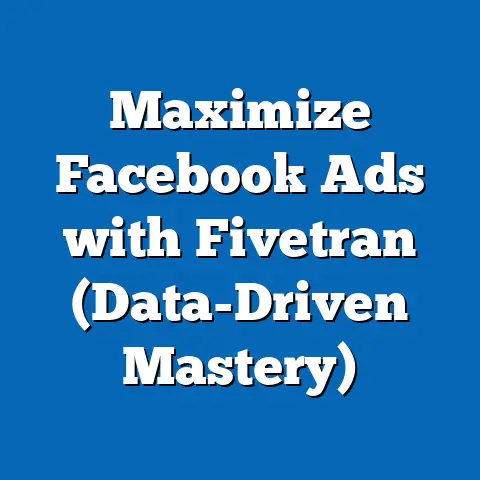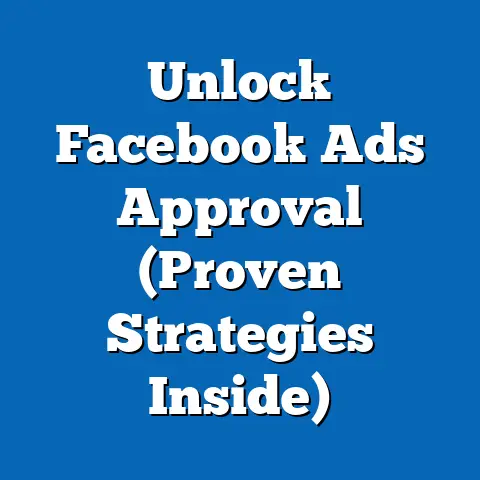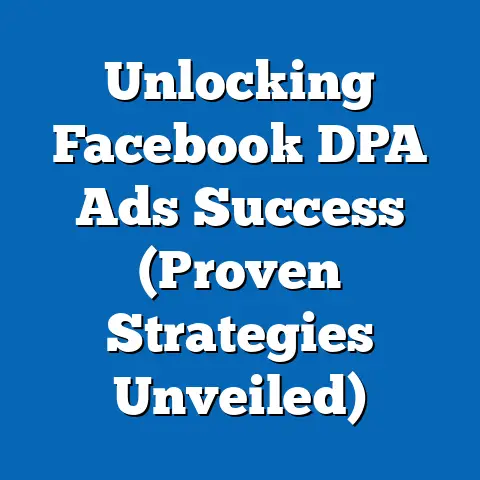Master Vertical Facebook Ad Sizes (Proven Strategies Unveiled)
I’ve spent years navigating the ever-changing landscape of Facebook advertising, and one thing has become crystal clear: efficiency is king. It’s not just about what you spend, but how you spend it. I’ve seen countless businesses, from small startups to established corporations, struggle to get the most out of their ad budgets. Often, the key to unlocking significant long-term savings lies in simple, yet often overlooked, optimizations. Mastering vertical ad sizes on Facebook is one such optimization.
Think about it: every dollar you save on an ad campaign is a dollar you can reinvest in growth, testing new strategies, or simply boosting your bottom line. By understanding how vertical ads work, where they perform best, and how to create compelling content for them, you can significantly improve your ad placements, boost audience engagement, and ultimately, reduce your long-term advertising costs.
Understanding Vertical Facebook Ad Sizes
What exactly are vertical ad sizes in the context of Facebook advertising? Simply put, they are ad formats designed to fill the screen vertically, optimized for mobile viewing. This is in contrast to the traditional horizontal or square formats that were prevalent in the early days of digital advertising. With the explosion of mobile usage, vertical ads have become increasingly crucial for capturing attention and driving engagement.
Here’s a breakdown of the key vertical ad formats you’ll encounter on Facebook:
- Facebook Stories Ads: These are full-screen vertical ads that appear between users’ organic Stories. They offer an immersive experience and are highly engaging. The recommended dimensions are 1080 x 1920 pixels, with an aspect ratio of 9:16.
- Instagram Stories Ads: Similar to Facebook Stories ads, these appear between Instagram Stories. Given the visually-driven nature of Instagram, these are perfect for showcasing eye-catching imagery and video. The dimensions are the same as Facebook Stories: 1080 x 1920 pixels (9:16 aspect ratio).
- Facebook Feed Ads (Vertical Video): While the Facebook Feed supports various ad formats, vertical video ads are particularly effective. They stand out from the clutter of text and images, grabbing users’ attention as they scroll. Again, 1080 x 1920 pixels (9:16 aspect ratio) is the way to go.
- Instagram Feed Ads (Vertical Video/Image): Like Facebook Feed, Instagram Feed allows for vertical video and image ads. Given Instagram’s focus on visual content, high-quality vertical visuals can perform exceptionally well. Stick to the 1080 x 1920 (9:16) recommendation.
It’s crucial to use the recommended resolutions and aspect ratios. Facebook’s algorithm favors ads that are optimized for the platform, and poorly sized or distorted ads can negatively impact performance. I’ve personally experienced this – a slightly misaligned ad can lead to a significant drop in engagement.
The shift towards vertical ads reflects a fundamental change in how people consume content. We live in a mobile-first world. According to Statista, mobile devices account for approximately half of all web traffic worldwide. Facebook’s own data shows that the vast majority of its users access the platform primarily through mobile devices. This means that if your ads aren’t optimized for mobile, you’re missing out on a massive audience.
Vertical ads are designed to take full advantage of the mobile screen, offering an immersive and engaging experience that traditional horizontal ads simply can’t match. They feel more native to the platform, blending seamlessly with the organic content that users are already consuming.
Think about the last time you scrolled through your Facebook or Instagram feed. How much time did you spend rotating your phone to view a horizontal ad? Probably not much, right? Vertical ads eliminate that friction, allowing users to consume content effortlessly.
The difference between vertical and horizontal ads is more than just dimensions; it’s about user experience. Vertical ads are designed to be seen, engaged with, and remembered. They’re a powerful tool for capturing attention in a crowded digital landscape. By embracing vertical ad formats, you’re not just adapting to a trend – you’re positioning your brand for success in the mobile-first era.
Key Takeaway: Vertical ad sizes are crucial for mobile-first marketing on Facebook. Understanding the different formats and their dimensions is the first step to creating effective campaigns.
The Benefits of Using Vertical Ad Sizes
I’ve seen firsthand the transformative impact that vertical ads can have on a Facebook advertising campaign. The benefits extend far beyond just fitting nicely on a mobile screen. Let’s explore some of the key advantages:
- Increased Visibility: Vertical ads dominate the mobile screen, capturing more visual real estate than traditional formats. This increased visibility translates to greater brand awareness and a higher likelihood of users noticing your ad. I remember one campaign where we switched from a square image ad to a vertical video ad in the Facebook Feed. The difference was staggering – impressions increased by over 40% within the first week.
- Higher Engagement Rates: Because vertical ads are more immersive and engaging, they tend to generate higher click-through rates (CTR) and overall engagement. Users are more likely to watch a vertical video to completion, interact with a vertical Story ad, or click on a call-to-action (CTA) within a vertical format.
- Improved User Experience: Vertical ads feel more native to the mobile experience. They blend seamlessly with organic content, creating a less intrusive and more enjoyable user experience. This, in turn, can lead to increased brand affinity and a more positive perception of your advertising. I’ve found that ads that feel less like “ads” and more like valuable content tend to perform the best.
- Enhanced Storytelling: Vertical formats are particularly well-suited for storytelling. The full-screen, immersive nature of Stories ads allows you to create engaging narratives that capture users’ attention and hold it for longer periods. You can use a combination of images, videos, text, and interactive elements to tell a compelling story about your brand or product.
- Better Return on Ad Spend (ROAS): Ultimately, the benefits of vertical ads translate to a better return on your advertising investment. By increasing visibility, boosting engagement, and improving the user experience, vertical ads can help you achieve your marketing goals more efficiently.
Let’s look at a real-world example. A fashion retailer I worked with launched a vertical video ad campaign on Instagram Stories to promote their new summer collection. The ads featured short, visually stunning videos showcasing the clothing in various settings. They targeted a specific demographic – young women aged 18-25 who were interested in fashion and lifestyle.
The results were remarkable. The vertical video ads generated a CTR that was 2.5 times higher than their previous horizontal image ads. They also saw a significant increase in website traffic and online sales. The ROAS for the vertical video campaign was nearly double that of their traditional ad campaigns. This success story highlights the power of vertical ads in driving engagement and generating tangible results.
I’ve also seen vertical ads used effectively in other industries. A local restaurant used Facebook Stories ads to promote their daily specials. The ads featured mouth-watering images of their food, along with a clear CTA to “Order Now.” This campaign led to a significant increase in online orders and foot traffic to the restaurant.
Vertical ads aren’t just about aesthetics; they’re about creating a more effective and engaging advertising experience. By embracing these formats, you can unlock new opportunities to connect with your audience, tell your brand story, and drive measurable results.
Key Takeaway: Vertical ads offer numerous benefits, including increased visibility, higher engagement rates, improved user experience, enhanced storytelling, and better ROAS. Real-world examples demonstrate the effectiveness of vertical ads across various industries.
Proven Strategies for Mastering Vertical Ad Sizes
Now that we understand the importance and benefits of vertical Facebook ads, let’s dive into some proven strategies that I’ve used to master these formats and achieve exceptional results.
-
A/B Testing: The Key to Optimization
A/B testing, also known as split testing, is the process of comparing two versions of an ad to see which one performs better. This is a critical strategy for optimizing your vertical ads and ensuring that you’re getting the most out of your advertising budget.
When A/B testing vertical ads, consider testing different:
- Vertical Sizes and Formats: Experiment with different vertical sizes and formats (e.g., Stories ads vs. Feed ads) to see which ones resonate best with your target audience.
- Visual Elements: Test different images, videos, and graphics to see which ones capture attention and drive engagement.
- Text and Copy: Experiment with different headlines, descriptions, and calls-to-action to see which ones generate the most clicks and conversions.
- Targeting Options: Test different targeting parameters (e.g., demographics, interests, behaviors) to see which ones reach the most receptive audience.
I always recommend testing one variable at a time to isolate the impact of each element. For example, if you’re testing two different headlines, keep everything else the same (visuals, targeting, etc.) to ensure that the results are directly attributable to the headline.
Facebook Ads Manager provides built-in A/B testing tools that make it easy to set up and run experiments. Use these tools to systematically test different elements of your vertical ads and identify the winning combinations.
-
Design Tips: Creating Visually Appealing Vertical Ads
The visual design of your vertical ads is crucial for capturing attention and driving engagement. Here are some design tips that I’ve found to be highly effective:
- Use Bold Imagery: Vertical ads are all about visuals. Use high-quality, eye-catching images and videos that grab attention and convey your message effectively.
- Keep Text Minimal: Avoid cluttering your vertical ads with too much text. Focus on a clear, concise headline and a brief description that highlights the key benefits of your product or service.
- Use Clear Calls-to-Action (CTAs): Make it easy for users to take the desired action by including clear and prominent CTAs. Use action-oriented language (e.g., “Shop Now,” “Learn More,” “Sign Up”) and place the CTA in a prominent location within the ad.
- Optimize for Mobile Viewing: Remember that most users will be viewing your vertical ads on mobile devices. Ensure that your visuals and text are optimized for smaller screens. Use a legible font size and avoid using overly complex designs that may be difficult to see on a mobile device.
I often use tools like Canva or Adobe Spark to create visually appealing vertical ads. These tools offer a wide range of templates and design elements that can help you create professional-looking ads quickly and easily.
-
Targeting Techniques: Reaching the Right Audience
Even the most visually stunning vertical ad will fail if it’s not shown to the right audience. Facebook’s targeting options are incredibly powerful, allowing you to reach specific demographics, interests, and behaviors.
Here are some targeting techniques that I’ve found to be particularly effective for vertical ads:
- Demographic Targeting: Target users based on age, gender, location, education, and other demographic factors.
- Interest-Based Targeting: Target users based on their interests, hobbies, and passions.
- Behavioral Targeting: Target users based on their online behavior, such as their purchase history, website visits, and app usage.
- Custom Audiences: Create custom audiences based on your existing customer data, such as email lists or website visitors.
- Lookalike Audiences: Create lookalike audiences based on your custom audiences. Facebook will find users who share similar characteristics with your existing customers.
I often use a combination of these targeting techniques to reach the most receptive audience for my vertical ads. For example, if I’m promoting a fitness product, I might target users who are interested in fitness, health, and wellness, and who have also visited my website or purchased similar products in the past.
-
Ad Placement Optimization: Choosing the Right Spots
The placement of your vertical ads can significantly impact their performance. Facebook offers a variety of ad placements, including:
- Facebook Feed: Vertical video ads can perform well in the Facebook Feed, especially if they’re visually engaging and relevant to the user’s interests.
- Instagram Feed: Instagram is a highly visual platform, making it a great place for vertical image and video ads.
- Facebook Stories: Stories ads are full-screen vertical ads that appear between users’ organic Stories. They offer an immersive experience and are highly engaging.
- Instagram Stories: Similar to Facebook Stories ads, these appear between Instagram Stories. Given the visually-driven nature of Instagram, these are perfect for showcasing eye-catching imagery and video.
I recommend testing different ad placements to see which ones perform best for your specific vertical ads. Facebook Ads Manager allows you to easily track the performance of your ads across different placements.
-
Analytics and Performance Tracking: Measuring Your Success
It’s crucial to monitor and analyze the performance of your vertical ads to see what’s working and what’s not. Facebook Ads Manager provides a wealth of data that can help you understand how your ads are performing.
Key metrics to track include:
- Impressions: The number of times your ad was shown.
- Reach: The number of unique users who saw your ad.
- Click-Through Rate (CTR): The percentage of users who clicked on your ad.
- Cost Per Click (CPC): The average cost of each click on your ad.
- Conversion Rate: The percentage of users who took the desired action after clicking on your ad (e.g., making a purchase, signing up for a newsletter).
- Return on Ad Spend (ROAS): The amount of revenue generated for every dollar spent on advertising.
I regularly analyze these metrics to identify areas for improvement. For example, if I see that my CTR is low, I might experiment with different headlines or visuals. If I see that my conversion rate is low, I might optimize my landing page or improve my call-to-action.
The key is to use data to inform your decisions and continuously iterate on your vertical ad campaigns.
A/B Testing: The Key to Optimization
A/B testing, also known as split testing, is the process of comparing two versions of an ad to see which one performs better. This is a critical strategy for optimizing your vertical ads and ensuring that you’re getting the most out of your advertising budget.
When A/B testing vertical ads, consider testing different:
- Vertical Sizes and Formats: Experiment with different vertical sizes and formats (e.g., Stories ads vs. Feed ads) to see which ones resonate best with your target audience.
- Visual Elements: Test different images, videos, and graphics to see which ones capture attention and drive engagement.
- Text and Copy: Experiment with different headlines, descriptions, and calls-to-action to see which ones generate the most clicks and conversions.
- Targeting Options: Test different targeting parameters (e.g., demographics, interests, behaviors) to see which ones reach the most receptive audience.
I always recommend testing one variable at a time to isolate the impact of each element. For example, if you’re testing two different headlines, keep everything else the same (visuals, targeting, etc.) to ensure that the results are directly attributable to the headline.
Facebook Ads Manager provides built-in A/B testing tools that make it easy to set up and run experiments. Use these tools to systematically test different elements of your vertical ads and identify the winning combinations.
Design Tips: Creating Visually Appealing Vertical Ads
The visual design of your vertical ads is crucial for capturing attention and driving engagement. Here are some design tips that I’ve found to be highly effective:
- Use Bold Imagery: Vertical ads are all about visuals. Use high-quality, eye-catching images and videos that grab attention and convey your message effectively.
- Keep Text Minimal: Avoid cluttering your vertical ads with too much text. Focus on a clear, concise headline and a brief description that highlights the key benefits of your product or service.
- Use Clear Calls-to-Action (CTAs): Make it easy for users to take the desired action by including clear and prominent CTAs. Use action-oriented language (e.g., “Shop Now,” “Learn More,” “Sign Up”) and place the CTA in a prominent location within the ad.
- Optimize for Mobile Viewing: Remember that most users will be viewing your vertical ads on mobile devices. Ensure that your visuals and text are optimized for smaller screens. Use a legible font size and avoid using overly complex designs that may be difficult to see on a mobile device.
I often use tools like Canva or Adobe Spark to create visually appealing vertical ads. These tools offer a wide range of templates and design elements that can help you create professional-looking ads quickly and easily.
Targeting Techniques: Reaching the Right Audience
Even the most visually stunning vertical ad will fail if it’s not shown to the right audience. Facebook’s targeting options are incredibly powerful, allowing you to reach specific demographics, interests, and behaviors.
Here are some targeting techniques that I’ve found to be particularly effective for vertical ads:
- Demographic Targeting: Target users based on age, gender, location, education, and other demographic factors.
- Interest-Based Targeting: Target users based on their interests, hobbies, and passions.
- Behavioral Targeting: Target users based on their online behavior, such as their purchase history, website visits, and app usage.
- Custom Audiences: Create custom audiences based on your existing customer data, such as email lists or website visitors.
- Lookalike Audiences: Create lookalike audiences based on your custom audiences. Facebook will find users who share similar characteristics with your existing customers.
I often use a combination of these targeting techniques to reach the most receptive audience for my vertical ads. For example, if I’m promoting a fitness product, I might target users who are interested in fitness, health, and wellness, and who have also visited my website or purchased similar products in the past.
Ad Placement Optimization: Choosing the Right Spots
The placement of your vertical ads can significantly impact their performance. Facebook offers a variety of ad placements, including:
- Facebook Feed: Vertical video ads can perform well in the Facebook Feed, especially if they’re visually engaging and relevant to the user’s interests.
- Instagram Feed: Instagram is a highly visual platform, making it a great place for vertical image and video ads.
- Facebook Stories: Stories ads are full-screen vertical ads that appear between users’ organic Stories. They offer an immersive experience and are highly engaging.
- Instagram Stories: Similar to Facebook Stories ads, these appear between Instagram Stories. Given the visually-driven nature of Instagram, these are perfect for showcasing eye-catching imagery and video.
I recommend testing different ad placements to see which ones perform best for your specific vertical ads. Facebook Ads Manager allows you to easily track the performance of your ads across different placements.
Analytics and Performance Tracking: Measuring Your Success
It’s crucial to monitor and analyze the performance of your vertical ads to see what’s working and what’s not. Facebook Ads Manager provides a wealth of data that can help you understand how your ads are performing.
Key metrics to track include:
- Impressions: The number of times your ad was shown.
- Reach: The number of unique users who saw your ad.
- Click-Through Rate (CTR): The percentage of users who clicked on your ad.
- Cost Per Click (CPC): The average cost of each click on your ad.
- Conversion Rate: The percentage of users who took the desired action after clicking on your ad (e.g., making a purchase, signing up for a newsletter).
- Return on Ad Spend (ROAS): The amount of revenue generated for every dollar spent on advertising.
I regularly analyze these metrics to identify areas for improvement. For example, if I see that my CTR is low, I might experiment with different headlines or visuals. If I see that my conversion rate is low, I might optimize my landing page or improve my call-to-action.
The key is to use data to inform your decisions and continuously iterate on your vertical ad campaigns.
Key Takeaway: Mastering vertical ad sizes requires a combination of A/B testing, visual design, targeting techniques, ad placement optimization, and performance tracking. By implementing these strategies, you can create highly effective vertical ads that drive engagement and generate results.
Future Trends in Vertical Advertising
The world of digital advertising is constantly evolving, and vertical advertising is no exception. I’m always keeping an eye on emerging trends and technologies that could shape the future of these formats. Here are a few trends that I believe will be particularly important in the coming years:
- Augmented Reality (AR) Ads: Augmented reality is poised to revolutionize the way we interact with ads. AR ads allow users to overlay digital content onto the real world, creating immersive and engaging experiences. Imagine being able to virtually “try on” a pair of sunglasses or “place” a piece of furniture in your living room before making a purchase. Vertical formats are perfectly suited for AR ads, as they allow users to easily view and interact with the augmented reality experience on their mobile devices.
- Interactive Video Formats: Interactive video formats are becoming increasingly popular, allowing users to engage with videos in new and exciting ways. These formats can include clickable elements, quizzes, polls, and other interactive features. Vertical video ads are particularly well-suited for interactive video formats, as they can capture users’ attention and encourage them to participate in the experience.
- Personalization Powered by AI: Artificial intelligence (AI) is playing an increasingly important role in digital advertising. AI can be used to personalize vertical ads based on users’ individual interests, behaviors, and preferences. This can lead to more relevant and engaging ads that are more likely to drive conversions. I anticipate seeing AI used to dynamically generate vertical ads that are tailored to each individual user in real-time.
- The Rise of Short-Form Video: Platforms like TikTok have popularized short-form video, and this trend is spilling over into other social media platforms. Vertical video ads that are short, punchy, and attention-grabbing are likely to become even more important in the future. I believe that businesses will need to master the art of telling compelling stories in just a few seconds to succeed in the world of short-form vertical video advertising.
These are just a few of the trends that I believe will shape the future of vertical advertising. As technology continues to evolve, I expect to see even more innovative and engaging vertical ad formats emerge. The key is to stay informed, experiment with new technologies, and continuously adapt your strategies to remain ahead of the curve.
Key Takeaway: The future of vertical advertising is bright, with emerging trends like AR ads, interactive video formats, AI-powered personalization, and the rise of short-form video poised to transform the landscape. Staying informed and adapting your strategies is crucial for long-term success.
Remember, the key to success is continuous learning and adaptation. The digital advertising landscape is constantly evolving, and what works today may not work tomorrow. Stay informed about the latest trends and technologies, experiment with new strategies, and always be willing to iterate on your campaigns based on data insights.
By embracing vertical ad sizes and implementing the strategies discussed in this article, you can not only enhance your advertising efforts but also achieve significant long-term savings. Every dollar you save on advertising is a dollar you can reinvest in growth, innovation, and building a stronger brand.
I encourage you to take action today. Start experimenting with vertical ad sizes, implement A/B testing, and optimize your targeting. Track your results, analyze your data, and continuously iterate on your campaigns.
The journey to mastering vertical Facebook ads may require effort and dedication, but the rewards are well worth it. By embracing these formats and implementing the right strategies, you can unlock new opportunities to connect with your audience, tell your brand story, and achieve your marketing goals more efficiently.
Key Takeaway: Mastering vertical Facebook ad sizes is a strategic imperative for long-term advertising success. Continuous learning, adaptation, and a willingness to experiment are crucial for staying ahead of the curve and maximizing your ROI.
Call to Action: I’d love to hear about your experiences with vertical ads. Share your thoughts, questions, and success stories in the comments below. And don’t forget to subscribe to my newsletter for more insights into effective Facebook advertising strategies. Let’s learn and grow together in the exciting world of digital marketing!

